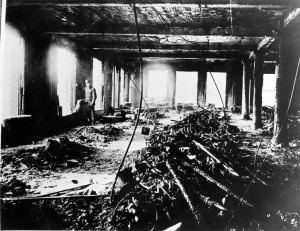Last week, a garment factory collapsed in Bangladesh, India. Initial reports claimed that at least 87 people died in the accident, but the total of number of deaths from the collapse is now believed to be about four hundred, with thousands of others wounded. Massive cracks were reported in the building the day before the collapse, but the owner Mohammed Sohel Rana ignored the warning signs and demanded his employees keep working. On Sunday, April 28, Rana was arrested trying to flee Bangladesh, and will face responsibility for the collapse.
This tragic story has understandably attracted much international attention. Unfortunately, it’s not the first time that an event like this has occurred. Last November, a fire at a different Bangladeshi garment factory killed 112 people (we wrote about it here). Another factory collapse eight years ago, killing 64. And these are just a few of the incidences of tragically unsafe working conditions in Bangladesh, where the garment industry brings in some $20 billion a year, but the workers typically make little more than $38 a month.
Hearing about these incidents, one is reminded of the Triangle Shirtwaist Factory fire of 1911. In that famous tragedy, 146 workers at a New York garment factory were killed when a fire broke out during work hours. The fire spread quickly due to unsafe work conditions, and workers were unable to escape the blaze because the factory’s owners had locked the doors in an effort to prevent the workers from taking unauthorized breaks. The fire attracted national attention, and prompted new laws and regulations in America to protect workers.
Unfortunately, those laws are not in effect in other parts of the world, where sweat shops and unsafe conditions still are dominant. (That’s not to say that American companies don’t continue to flaunt rules and safety regulations: the Texas fertilizer plant that exploded on April 17, 2013, killing more than fifteen people and injuring many more, had 1,350 times the amount of explosive ammonium nitrate than what is allowed by the Department of Homeland Security on its premises.) But with the constant international scrutiny allowed by the internet, one hopes that things will change.The changes may even be made for economic reasons: in the wake of the Bangladesh collapse, many of the major corporations whose products are made there are working on plans to ensure worker safety. Meanwhile, the European Union is considering taking action against Bangladesh, threatening the preferential treatment the country receives from the Union that makes these factories so profitable. Sadly, like with the Triangle Shirtwaist Factory fire, it takes an unthinkable tragedy to spur any kind of action.
To learn more about the Triangle Shirtwaist Factory fire, please check out The Triangle Shirtwaist Factory Fire (ISBN# 978-1-59935-099-8) by Donna Getzinger from your local library, or purchase it as an Ebook from Morgan Reynolds Publishing.
-Josh Barrer
Associate Editor


